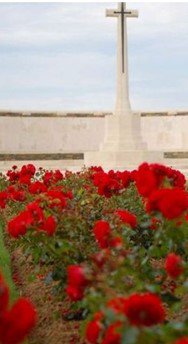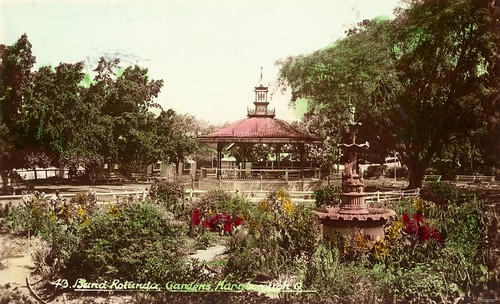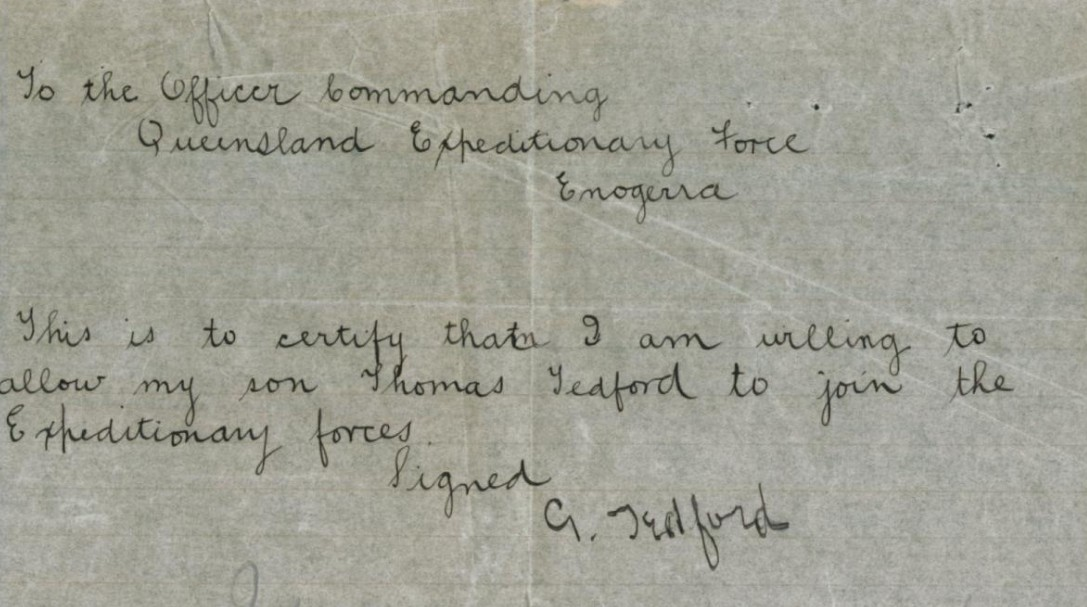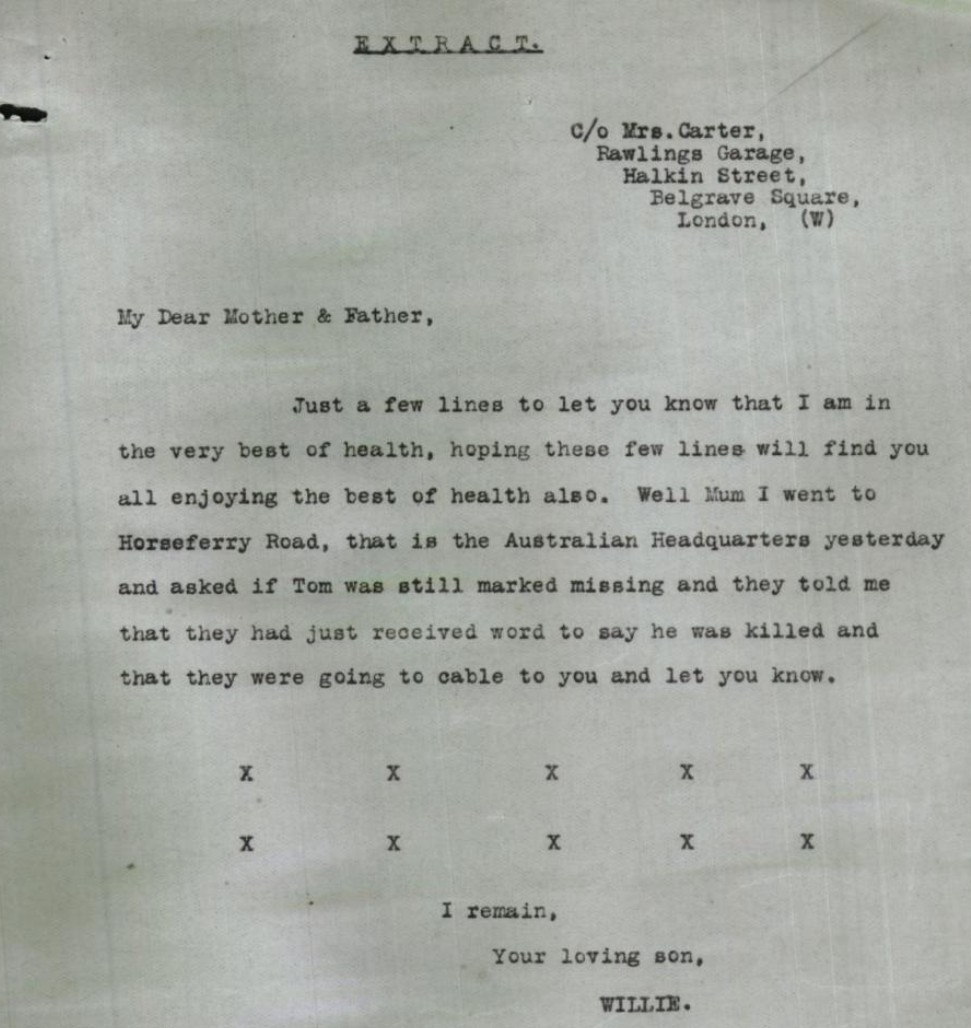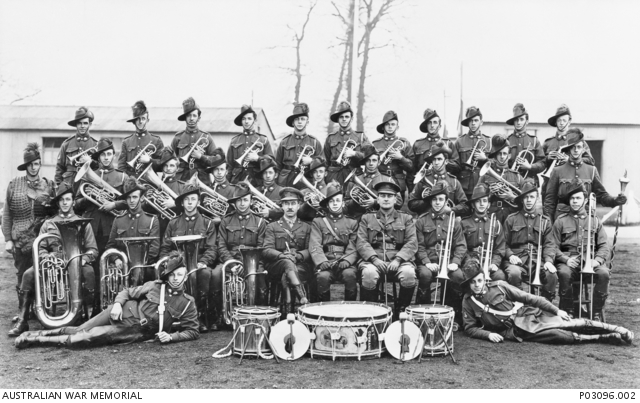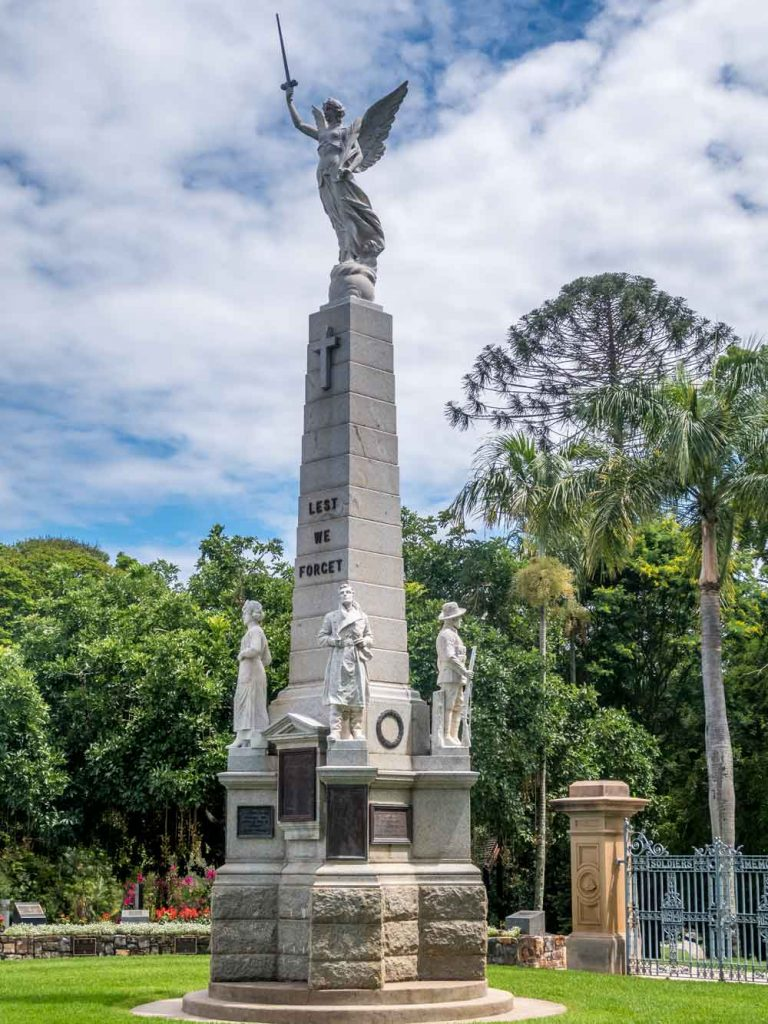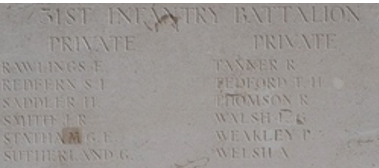Thomas Henry TEDFORD
Eyes brown, Hair dark, Complexion dark
Two Sons of Maryborough, The Tedford Brothers
Early Life
Thomas Henry Tedford “Tom” and his older brother William Edward Tedford “Billie” were born into a close-knit and musically gifted family in Maryborough, Queensland. Billie was born in 1894 in Gympie, while Tom followed two years later, born on 3 March 1896 in Maryborough.
Their parents, George William Tedford 1853-1929 and Elizabeth Tedford (née Winston) 1863-1943, were long-standing members of the Maryborough, Torquay and Hervey Bay communities.
Children of George and Elizabeth:
- Jack (John Benjamin), 1891-1950 m Florence Milne
- George Winston, 1892-1894 died infancy
- Billie (William Edward), 1894-1968 m Annie Robinson
- Tom (Thomas Henry), 1896-1916 Fromelles
George was born in Upper Baragh, Drumcree Parish, Ireland, and emigrated to Queensland in 1877 aboard the Saraca. He began work at Walkers Ltd and later joined the Queensland Railway Department, where he rose to the rank of locomotive driver. Elizabeth, born in 1864, was of the Winston and Cannell families, with deep roots in colonial Queensland. The Tedfords were a devoted musical family, particularly involved in Maryborough’s brass band tradition. George was a founding member and E-flat bass player in the City Band.
Each of his sons played an instrument, Jack was a celebrated drummer, Billie a champion BB bass player, and Tom — remembered affectionately by fellow bandsmen — was described as “the life and soul of all.” The boys grew up in Albert Street, Maryborough, surrounded by family, community, music, and faith. They were raised Methodist, and all three sons — Jack, Billie, and Tom — would go on to serve their town and country, each in their own way.
Tragically, one son, George Winston Tedford, died in infancy. The remaining three shared a strong bond — one that would later carry them into wartime service. Before enlisting, Tom worked as a machinist, while Billie was employed as a labourer. Both were described as fit, cheerful, and well-liked. Like many in regional Queensland, they enlisted not for glory, but out of a sense of duty — to their mates, their town, and to each other.
Enlistment and Training
Tom was the first of the two brothers to enlist. On 28 May 1915, at just 19 years old, he signed up in Brisbane and was posted to the 25th Battalion (3rd Reinforcement). Already serving with the 4th Infantry, Citizen Military Forces in Maryborough, he was well-prepared for military life. A machinist by trade and known for his cheerful nature and musical tale, , Tom entered the AIF with a strong sense of purpose.
Not long after, his older brother Billie followed in his footsteps. He enlisted on 16 August 1915, also in Brisbane, aged 21. A labourer by occupation, Billie was posted to the 31st Battalion Headquarters, one of the earliest Queenslanders assigned to this new battalion. The two brothers were soon reunited in Egypt, where their military journey truly began.
Tom embarked on HMAT A55 Kyarra from Brisbane on 16 August 1915, and Billie departed Melbourne in November aboard A62 Wandilla . Both were headed to Egypt, where the 31st Battalion would complete its formation and initial training. The brothers were stationed in the desert camps and later at Tel el Kebir, where Tom officially joined the 31st Battalion on 29 February 1916, becoming part of A Company.
In a letter home, written just weeks before the Battle of Fromelles, Billie described some of their time in Egypt and the journey to France:
“We had a splendid trip over here from Egypt, and as you may have heard we were lucky to arrive in France safely... At Marseilles for a night, we boarded a train for our three days’ journey to the front. We saw some fine and interesting sights... farms and orchards all being worked by women — some very old too — and very few men to be seen, except as soldiers.”
He wrote of his excitement at seeing the Eiffel Tower in the distance, the kindness of French civilians who waved and cheered the Australians along the railway route, and the coffee and bread provided by the Red Cross at various stations. He also described how Australian soldiers, short on rations, still refused to take food from poor villagers, despite generous offers:
”We Australians refuse to take their food from the poor women, although they freely offer it for nothing.”
On 16 June 1916, the 31st Battalion boarded ships to cross the Mediterranean and officially joined the British Expeditionary Force. The Tedford brothers disembarked at Marseilles on 23 June, bound for the trenches of northern France. Their battalion would soon lead the 5th Division into the first major Australian engagement on the Western Front: the Battle of Fromelles.
Brothers at the Front
By late June 1916, the Tedford brothers had completed their training in Egypt and arrived in France. They were billeted together in farmhouses near the front lines, and it was clear from Billie’s letter that both he and Tom were in good spirits:
“He and his brother Tom... were in first class health.”— Pte W.E. Tedford, 28 June 1916
Billie wrote home vividly about their journey through France — the cheering French villagers, the Red Cross volunteers handing out bread and coffee at stations, and the awe of seeing the Eiffel Tower in the distance. As they travelled toward the front lines, the difference between life in Australia and war-torn France became stark:
“We are now camped in farm houses, the band being all together in a barn, and can plainly hear the sounds of battle a short distance away.”
He described the long daylight hours, the devastation of the countryside, and the emotional toll on local women, many of whom had lost husbands and sons to the war:
“The women folk say ‘War no good’ and cry as they speak. These people are going through hard times.”
The battalion soon received orders to move into the front lines. Billie noted:
“We are moving into the first line of trenches tomorrow, and things seem to be very warm there just now... The bombardments are dreadful, and one can scarcely get a wink of sleep at first till he gets used to it, for it seems to shake the very earth.”
One story stayed with Billie: the accidental tragedy of war playing out even for civilians:
“The other day, a little French boy was near our billet with his sister, and he picked up a live bomb, and it went off — blew three of his fingers off and his poor little sister’s eye out also.”
The closer they moved to the front, the more direct their exposure became. Billie described enduring a German gas attack, but also showed confidence in their equipment:
“We have had our first dose of German gas... but it was not too bad — we have capital gas helmets and are quite safe. We also had a specimen of their weeping gas which makes one's eyes terribly sore, but as we have special glasses, we are also safe.”
Despite the conditions, Billie was proud that their unit had been chosen for a leading role:
“Our battalion has been chosen to lead the 5th Division, which is considered a very great honour indeed.”
He remained hopeful for survival — and for return:
“I can assure you we will do our best... If we are lucky, we shall be home with you no later than next Easter.”
It was the last letter known to have been received before the battle. Less than three weeks later, on 18 July 1916, Billie was wounded in action with a gunshot wound to his right thigh— and the following evening, Tom was killed.
The Battle of Fromelles
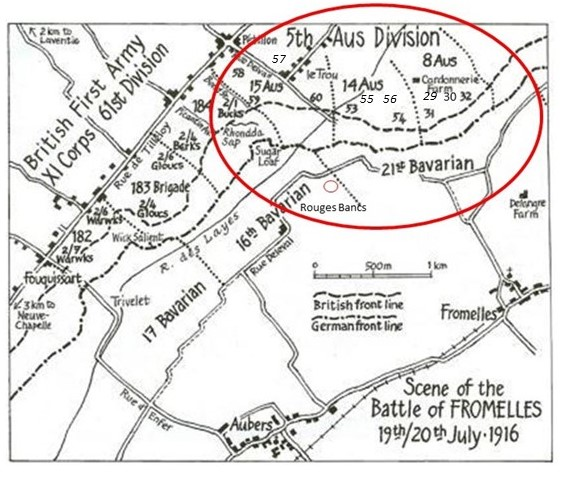
On 19–20 July 1916, the Tedford brothers and the men of the 31st Battalion were thrown into one of the most disastrous battles in Australian military history — Fromelles. Only weeks after arriving on the Western Front, they faced an entrenched and well-prepared German enemy in an assault that would prove costly beyond measure.
The 31st Battalion formed part of the 8th Brigade, 5th Australian Division. Their orders were to launch a frontal attack across open ground, under cover of a preliminary bombardment that, ultimately, failed to neutralise the enemy machine guns and fortifications.
The 31st Battalion began the advance at 6:00 p.m. on 19 July, moving across No-Man’s-Land in multiple waves. Tom, in A Company, was among the first to go forward. Billie, in Battalion Headquarters, was wounded the day before — possibly during a preliminary bombardment or wiring party operation. Tom pressed on without his brother at his side.
What followed was carnage. The German lines were largely intact. As the Australians emerged, they were cut down by rifle fire, machine guns, and shrapnel. More than 5,500 Australians were killed, wounded, or captured in a single night.
For Tom, the end came quickly. Multiple Red Cross witness statements provided some similar yet conflicting reports of his death.
1561 Private Roy W. Sheppard, A Company:
“On 19th July 1916, at Fleurbaix, Private Tedford was killed by shrapnel at about twenty past six.”
Sergeant Albert C. Compton, Bandmaster, 31st Battalion:
“I saw the latter Tedford lying out dead in No Man’s Land at Fleurbaix on the morning of 20.7.16... I was quite close to him... and I am quite sure it was Tedford and that he was dead.”
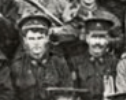
291 Private E. Smith, A Company:
“Informant states that on July 19th at Fleurbaix Tedford had his head blown clean off.”
Private H.H. Ford (Stretcher Bearer):
“On the night of July 19th, we stretcher bearers found him just near the trench now held by the Germans. He was quite dead and we concluded he must have been killed by concussion, as there were no marks about him.”
Despite efforts to recover the dead, Tom’s body was never identified. He has no known grave and is commemorated at the V.C. Corner Cemetery Memorial, Fromelles — along with more than 1,300 other Australians lost in the battle.
A telegram reporting him missing was received by the Mayor of Maryborough and published in the local newspaper:
“Private Tedford is a son of Mr. George Tedford and a brother of Private William E. Tedford, who was reported... as having been wounded. Much sympathy will be felt for the parents in their extreme anxiety.”
After the Battle
In the days and weeks following the Battle of Fromelles, Tom was first listed as missing in action. It would take months — and the painful confirmation from his mates — before the family learned the truth. Billie, recovering from his wounds, had written earlier that both he and Tom were in “first class health.” Now, only one of the brothers would return home.
The family received a letter from Major Percy Eckersley, 2nd in command of the 31st Battalion, who had personally known Tom:
“He was a grand soldier, and a distinct loss to our battalion. When his body was recovered it was found that there was not a mark on him. He had been killed by shell concussion... I saw him frequently and often had a little talk to him about home. He was always in good spirits. He died like a brave man... There were many tears shed on that awful day over the death of so many brave comrades.”
A simple but heartfelt death notice appeared in The Brisbane Courier:
“TEDFORD.—On July 20th, 1916 (killed in action), France, Private Tom H. Tedford, beloved youngest son of George and Lizzie Tedford.”
Tom’s death struck the Maryborough community deeply. In December 1916, a local poet known only as “Bannerman” published a tribute in the Maryborough Chronicle, reflecting the town’s admiration for the cheerful, musical young man they had lost:
VALE, TOM TEDFORD
Yes, that's his photo over there
Suspended from the wall.
You see his khaki uniform,
His figure lithe and tall.
We pride that picture dearly,
Far more than words can tell,
Because he fought in Freedom's fight
And nobly fighting fell.
And well do we remember him,
The boy in days gone by,
His merry, smiling features,
andThe laughter in his eye.
Tho' full of boyish mischief,
Yet manly, straight and true,
He looked a gallant soldier
When last he bade adieu.
He proved a splendid comrade,
The life and soul of all,
When there was risky work to do
'Twas Tom who heard the call.
He came of good old English stock
Who never slunk away,
When King and Country called them
To enter in the fray.
Long will his name be honoured
He died midst shot and shell,
A gallant soul went westward
When Thomas Tedford fell.
— Bannerman, Maryborough, 14 December 1916
Tom was just 20 years old. Billie, who survived his wounds, and was shipped to England on the 22nd July 1916. He made enquiries about his brother while there. Billie returned to Australia in March 1919. He married Annie Robinson in 1921 and had three children. His son Graham served with the RAAF in WW2. He would go on to live a full life, passing away in Brisbane in 1968.
Legacy and Remembrance
The loss of Tom left a lasting mark on the Tedford family and the Maryborough community. Though his body was never recovered, he was not forgotten:
- V.C. Corner Australian Cemetery Memorial at Fromelles
- Maryborough City Hall Honour Roll
- Maryborough Queen’s Park War Memorial
- Maryborough Excelsior Lodge No. 1 P.A.F.S.O.A.
- Australian War Memorial Roll of Honour (Panel 119)
The Tedford family's devotion to music also lived on. Eldest brother Jack was a beloved City Band drummer and railway worker. In 1950, he passed away at his Torquay residence — poignantly named “Fleurbaix” in memory of the battlefield where Tom fell:
“His late father (George) was a successful E-flat bass player, as was also his brother, the late Tom Tedford. ‘Billie’ Tedford was a champion BB bass player... The band will render Jack’s favourite hymn, ‘Lead Kindly Light’.”
Their father, George William Tedford, passed away in 1929 at the age of 76. He had been a railway driver, a founding member of the Maryborough City Band, and a widely respected member of the Masonic and Protestant Alliance communities. His funeral was one of the largest Maryborough had seen, attended by bandsmen from across the region:
“Throughout his life he was an exceptionally keen lover of brass bands... Deceased was always recognised as the ‘Father’ of the band.”
The Tedford legacy is one of service, music, and sacrifice — carried not just through the battlefield, but through the bonds of family, band, and town. Their mother was also well remembered:
Mrs. Elizabeth Tedford died at Torquay on Saturday at the age of 78 years. … born in Manchester (England) and came to Australia as a child. Most of her life was spent in Maryborough. For the last 18 years she lived at Torquay. Her husband, Mr.George Tedford, died 15 years ago. She is survived by two sons, Messrs. Jack Benjamin (Torquay) and William Edward Tedford(Ipswich). One son, Mr. Thomas Tedford, made the supreme sacrifice in the first World War.
Can you help us identify Private Tom Tedford?
Tom was killed during the Battle of Fromelles and has no known grave. His remains have not been formally identified among those recovered from the Pheasant Wood mass graves in 2009. Family have come forward to support the identification process, and DNA has been provided. Further matches through the Tedford or Winston lines may still assist in confirming a positive identification.
DNA samples are being sought for family connections to
| Soldier | Thomas Henry Tedford (1896–1916) |
| Parents | George William Tedford (1853–1929) and Elizabeth Winston (1864–1943) |
| Siblings | Jack (John Benjamin Tedford, 1891–1950, m. Florence Milne) | ||
| George Winston Tedford (1892–1894, died in infancy) | |||
| Billie (William Edward Tedford, 1894–1968, m. Annie Robinson) |
| Grandparents | |||
| Paternal | John Tedford (1832–1905) and Ellen Ford (1831–1911) | ||
| Maternal | Benjamin Winston (1833–1902) and Elizabeth Cannell (1836–1920) |
Links to Official Records
Seeking DNA Donors

Contacts
(Contact: carla@fromelles.info or geoffrey@fromelles.info).
(Contact: army.uwc@defence.gov.au or phone 1800 019 090).
Donations
If you are able, please contribute to the upkeep of this resource.
(Contact: bill@fromelles.info ).
